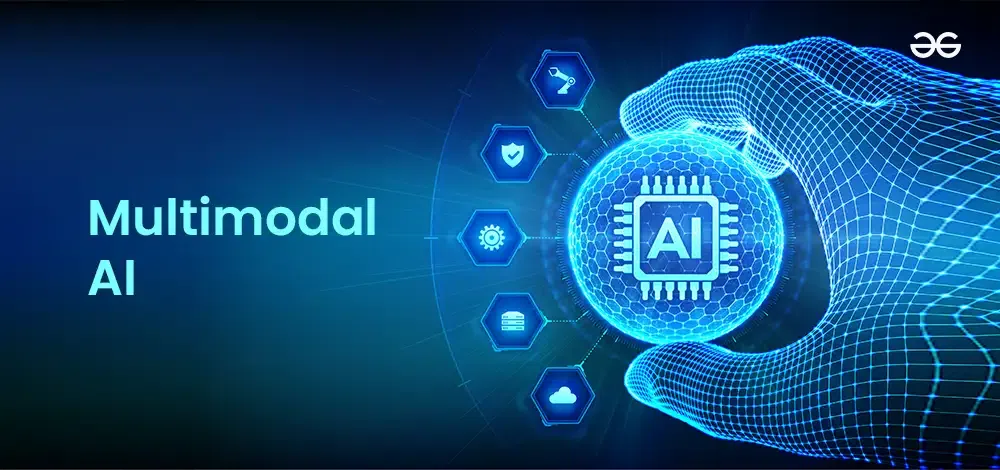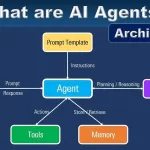Multimodal AI brings together knowledge from various resources such as text, images, audio, and video, thereby providing richer and deeper insights into a given scene.
In this sense, this approach differs from older models that focus solely on one type of data. Mixing different data streams provides multimodal AI with a much more contextual view of the world, allowing systems to learn and act more intelligently.
An application can connect visual details from a photo with relevant text to summarize what is happening at the scene. In its broader conception of machine learning, this approach goes far beyond single-modal tasks by combining various inputs, resulting in much more in-depth results. In essence, this mimics how, if people were observing a scene, they would look around, hear, listen, and read, organizing this process into an atmospheric computing environment.
Multimodal AI: How does it work?
Artificial intelligence is a rapidly evolving field: the latest advances in training algorithms for creating foundation models are being applied to multimodal search. This discipline has seen the birth of other multimodal innovations such as audiovisual speech recognition and multimedia content indexing, which had been developing before advances in deep learning and data science paved the way for generative AI .
Today, practitioners are using multimodal AI in all sorts of use cases, from medical image analysis in healthcare to using computer vision with other sensory inputs in AI-powered autonomous vehicles.
A 2022 article from Carnegie Mellon describes three characteristics of multimodal AI: heterogeneity, connections, and interactions. 1 Heterogeneity refers to the diverse qualities, structures, and representations of modalities. A descriptive text of an event will be fundamentally different in quality, structure, and representation from a photograph of the same event.
Connections refer to the complementary information shared between different modalities. These connections can be expressed through statistical similarities or semantic correspondences. Finally, interactions refer to how different modalities interact when brought together.
The main technical challenge of multimodal AI lies in the efficient integration and processing of various types of data to create models capable of leveraging the strengths of each modality while overcoming their individual limitations. The authors of the article also raised several challenges: representation, alignment, reasoning, generation, transfer, and quantification .
Multimodal AI applications
Health
Multimodal artificial intelligence brings together medical records, medical images, test results, and physician notes into a single, coherent perspective. This provides medical teams with rapid insights while gaining a holistic view of each patient’s condition. This improves diagnostic accuracy and personalized patient treatment.
Use cases:
- Analysis of X-ray and MRI images as well as the patient’s medical history to detect early signs of disease
- Cross-referencing pathology reports and genetic data for accurate treatment recommendations
- Extracting crucial textual details from physician notes to complement imaging studies
Social benefits :
- Faster and more accurate diagnosis on different media
- Agility and personalized care to improve treatment outcomes for patients
- Streamlined workflow that enables healthcare providers to manage complex cases more efficiently
E-commerce
Multimodal AI profiles will recommend products based on customer preferences, streamline searches, and optimize customer interaction processes on e-commerce sites. It brings together user behavior, text reviews, and product visuals to capture the nuances of user preferences that a single-modality engine might miss.
Use cases:
- Analysis of customer reviews and product images to determine the most popular aspects
- Combine browsing history with visual information to recommend complementary items
- Use user-submitted images or videos in style suggestions
Social benefits :
- Increased engagement through highly relevant product recommendations
- Improved conversion rates and ultimate customer satisfaction
- Increased brand loyalty through personalized aesthetic or functional classifications
Autonomous vehicles
Autonomous vehicles use multimodal AI to analyze environments, detect obstacles, and make instant decisions. The fusion of cameras, radars, lidars, and other sensor inputs allows for reality-checking of traffic conditions and other potentially dangerous situations.
Use cases:
- Pedestrian and vehicle recognition using a combination of camera vision and radar data.
- Lidar combines data from other sensors to improve object detection and distance estimation.
- Road surface anomalies are indicated to enable fusion of visual and sensor feedback by the driver.
Benefits :
- Reduced accidents through improved situational awareness.
- Reduction in the number of road accidents through improved navigation and collision prevention.
- Real-time traffic information helps reduce traffic congestion.
Training course
Multimodal AI supports personalized learning in education by analyzing text materials, video lessons, audio discussions, and interactive sessions. This large-scale approach allows teachers to understand student progress while adapting content to various learning styles.
Use cases:
- Summarize lessons in video to facilitate review and note-taking
- Tracking facial expressions in online classrooms to assess engagement
- Integrating audio commentary into student presentations with written critiques
Benefits :
- Better retention rates thanks to targeted support adapted to the needs of each student
- Increased engagement with multimodal and interactive teaching strategies
Finance
Multimodal AI in finance supports fraud detection, risk assessment, and customer service by analyzing transaction records, text data, and voice interactions. This synergistic overview provides subtle signs of irregularities and operational efficiency.
Use cases:
- Spot unusual spending patterns by cross-referencing transaction records and chatbot transcripts
- Analysis of loan documents and customer interactions for accurate approval
- Use voice analysis to detect possible deception or highly stressful conversations
Benefits :
- Accurate anomaly detection across multiple data channels prevents fraud
- Faster and more accurate credit assessment for customers
- Unified audio, text, and digital data drives excellent customer service
Key Benefits of Multimodal AI
Better accuracy
Comparing different forms of data reduces the risk of errors compared to a single-modality system.
Better understanding of the context
Multimodal AI has a much deeper meaning by merging various inputs.
Minimizing errors
The diversity of contributions allows confusing interpretations to be checked for better results.
Let’s take an example. Suppose a text analysis tool reaches conclusions that seem ambiguous. The system could examine some audiovisual data to support or refute the initial conclusions.
Challenges encountered in implementing multimodal AI
While multimodal AI has a possible future, its implementation presents many challenges.
Volume and complexity of data
Processing and analyzing large and diverse data sets requires advanced computing infrastructure and resources.
Data alignment conflicts
Aligning each modality becomes tricky because you need to ensure that each stream (i.e., text, images, and audio) is synchronized; otherwise, inaccuracies will occur.
Training data bias
Because datasets often inherit bias, curating the dataset to ensure diversity and fairness can lead to unintended and unfair results.
High costs
Building multimodal systems requires special hardware and software such as GPUs and other deployments across multiple machines, making them prohibitive for small organizations.
Shortage of qualified professionals
With the current market demand for experts specifically trained in multimodal AI, slow adoption is underway.
Data protection and privacy issues
Sharing between sources requires protection of sensitive data, which raises ethical and regulatory issues.
How Shaip can help you implement multimodal AI
At Shaip, we make it easy to implement multimodal AI by providing high-quality data solutions that meet your needs. Here’s how Shaip can help:
- Data Collection: Shaip provides various datasets (text, images, audio and video) from around the world to meet specific requirements.
- Accurate Annotation: Rendering services by annotation experts skilled in image segmentation, sentiment analysis, and object detection ensure accuracy.
- Unbiased Healthcare Data: Advanced Technological De-identification Measures to Eliminate Bias in Training Datasets Through Fair Trading.






